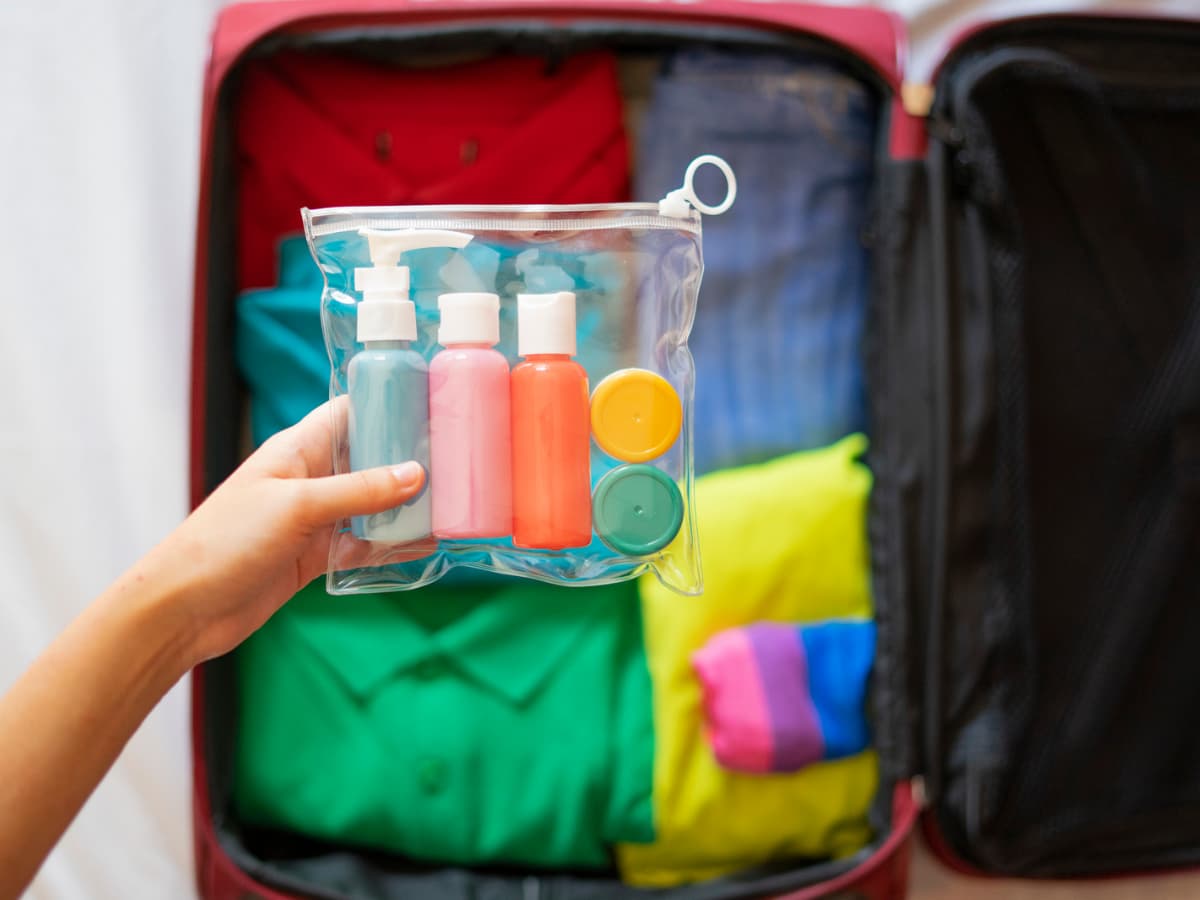Packing for a flight can be stressful. You want to make sure you have everything you need but also adhere to TSA rules.
One common question travelers have is: can I bring mouthwash on a plane? The short answer is yes, you can bring mouthwash in your carry-on or checked bag.
But there are some rules around sizing and quantities. Read on for a detailed guide on bringing mouthwash on an airplane.
If you’re short on time, here’s the quick answer: you can bring mouthwash on a plane, but it must follow the TSA’s 3-1-1 liquids rule for carry-ons.
This means mouthwash containers cannot exceed 3.4 ounces (100 ml) and must fit in a single, quart-sized bag with your other liquids, gels, and aerosols.
TSA Rules for Carry-On Mouthwash
3-1-1 Liquids Rule
When it comes to bringing mouthwash on a plane, it’s important to familiarize yourself with the Transportation Security Administration (TSA) rules. The TSA follows the 3-1-1 liquids rule, which states that all liquids, gels, and aerosols must be in containers that are 3.4 ounces (100 milliliters) or less, and all containers must fit into a single quart-sized clear plastic bag.
This includes mouthwash.
So, if your mouthwash container exceeds 3.4 ounces, unfortunately, you won’t be able to bring it in your carry-on luggage.
You can either leave it at home, transfer it to a smaller container, or pack it in your checked baggage if you don’t want to part with it.
Quantity Limitations
In addition to the 3-1-1 liquids rule, the TSA also imposes quantity limitations on certain items. However, mouthwash is not one of them.
As long as your mouthwash container meets the size requirements, you can bring as much mouthwash as you need for your trip.
It’s worth noting that the TSA may still require additional screening for larger quantities of liquids, so it’s always a good idea to be prepared for that possibility.
But as long as you’re within the size limits, you should be able to bring your mouthwash on board without any issues.
Consider Alternatives for Long Flights
While it’s generally allowed to bring small containers of mouthwash on a plane, it’s important to consider alternatives, especially for long flights.
Not only can mouthwash take up valuable space in your quart-sized bag, but it can also be inconvenient to use during the flight.
One option is to look for travel-sized mouthwash bottles that meet the TSA requirements. These smaller bottles are usually more compact and easier to fit into your carry-on luggage.
Another option is to use mouthwash tablets or strips, which can be dissolved in water to create a refreshing mouthwash solution.
Remember, it’s always a good idea to check the TSA website or contact your airline directly for the most up-to-date information on what is allowed in carry-on luggage. Each airline may have slightly different rules and regulations, so it’s better to be well-informed before your trip.
Checking Mouthwash in Luggage
Leak-Proof Containers
While there are no size restrictions for mouthwash in checked luggage, it’s important to ensure that the container is leak-proof. This is to prevent any spills or leaks during the flight, which can be inconvenient and messy.
Make sure the mouthwash bottle is tightly sealed and consider placing it in a plastic bag or wrapping it with a towel for added protection.
It’s worth noting that while there are no restrictions on bringing mouthwash in checked luggage, the rules may vary for carry-on luggage.
As per Transportation Security Administration (TSA) guidelines, liquids carried in carry-on bags must be in containers of 3.4 ounces (100 milliliters) or less and placed in a clear, quart-sized, zip-top bag.
Therefore, if you prefer to keep your mouthwash in your carry-on bag, make sure to transfer it into a smaller, TSA-approved container.
International Travel Restrictions
EU, UK, Canada Allow Up To 100 ml
When it comes to international travel, it’s important to be aware of the restrictions regarding carrying liquids in your carry-on luggage. In general, the EU, UK, and Canada follow similar rules when it comes to the amount of liquid you can bring on board.
According to these regulations, you are allowed to bring containers of liquids, including mouthwash, as long as each container is no more than 100ml or 3.4 ounces.
These containers must be placed in a clear, resealable plastic bag with a maximum capacity of 1 liter. This is known as the 100ml rule and is enforced to ensure the safety of all passengers onboard.
It’s important to note that the 100ml rule applies to the total volume of liquid you are carrying, regardless of the size of the container.
So even if you have a small bottle of mouthwash that is only half full, it will still count towards the 100ml limit.
It’s always a good idea to check the specific regulations of the country you are traveling to, as there may be additional restrictions or variations in their rules.

Tips for Traveling with Mouthwash
Traveling can be an exciting experience, but it’s important to be aware of the rules and regulations when it comes to carrying liquids on a plane. If you’re wondering whether you can bring mouthwash on a plane, the answer is yes!
However, there are a few things you should keep in mind to ensure a smooth and hassle-free journey.
Pack in Resealable Plastic Bags
When traveling with mouthwash, it’s a good idea to pack it in resealable plastic bags. This not only helps to prevent any leakage or spills but also makes it easier for security personnel to inspect your items.
The Transportation Security Administration (TSA) requires that all liquids, gels, and aerosols in your carry-on bag be placed in a clear, quart-sized bag.
By placing your mouthwash in a resealable plastic bag, you can easily remove it from your luggage and place it in the designated bin during the security screening process.
Opt for Travel-Sized Containers
If you’re planning a short trip or simply want to minimize the amount of liquid you carry, consider opting for travel-sized containers of mouthwash.
These containers are typically 3.4 ounces (100 milliliters) or less, which complies with the TSA’s guidelines for carrying liquids in your carry-on bag.
Travel-sized containers are not only convenient but also help to save space in your luggage. You can find a variety of travel-sized mouthwash options available in most drugstores or online.
Keep it Accessible in Your Carry-On
While you can bring mouthwash in your carry-on bag, it’s important to remember that all liquids must be easily accessible for inspection at the security checkpoint.
To avoid any delays or additional screening, keep your mouthwash within reach and separate it from other items in your bag.
This will allow security personnel to quickly and efficiently inspect your mouthwash without having to search through your belongings.
Alternatives to Packing Liquid Mouthwash
When it comes to traveling, the Transportation Security Administration (TSA) has strict rules regarding liquids in carry-on bags. This often leaves travelers wondering if they can bring mouthwash on a plane.
While the answer is generally yes, there are some restrictions and alternatives that can make your travel experience easier.
Mouthwash Tablets
Mouthwash tablets are a convenient and travel-friendly alternative to liquid mouthwash. These tablets are small, individually wrapped, and dissolve in water to create a refreshing mouth rinse.
Not only are they easy to pack and carry, but they also eliminate the worry of spilling or leaking in your luggage.
Many brands offer mouthwash tablets with different flavors, so you can still enjoy that fresh feeling without the hassle.
Breath Sprays
If you prefer a quick and easy solution for freshening your breath on the go, breath sprays are a great alternative to liquid mouthwash. These small, compact sprays fit easily in your pocket or purse, making them perfect for travel.
With just a quick spritz, you can enjoy a burst of minty freshness without the need for water or rinsing.
Tongue Scrapers
While not a direct replacement for mouthwash, tongue scrapers can be a helpful addition to your oral hygiene routine while traveling.
These small, handheld tools are designed to remove bacteria and debris from the surface of your tongue, helping to improve bad breath.
They are compact, easy to use, and don’t require any liquids, making them a convenient option when you can’t bring mouthwash on a plane.
Before your next trip, consider these alternatives to packing liquid mouthwash. They are practical, easy to use, and meet the TSA guidelines for carry-on liquids.
Remember to always check the latest TSA regulations and guidelines to ensure a smooth and hassle-free travel experience.
Conclusion
Hopefully this guide has provided everything you need to know about bringing mouthwash on an airplane.
The key things to remember are to follow the 3-1-1 rule for carry-ons, use leak-proof bottles in checked bags, and check international requirements.
With some preparation and planning, you’ll have fresh breath for your whole vacation or business trip. Safe travels!






